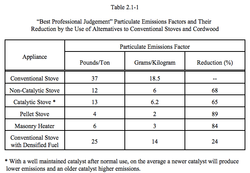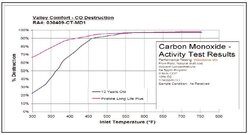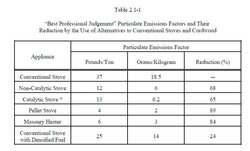I'm talking about long terms studies on the total stove/firewood/chimney setup.
There have been studies on catalytic converters. There have also been some in-home studies of stoves. In the first one, cat stoves came out worst than non-cats because of change over time in the stoves (not always the cats, but sometimes). Example - leaking bypass, etc.
In the second or last one I think the stove came out more similarly, but again there were not enough stoves and the study was not specifically to try and sort out stove designs, rather to see the total effect.
We know from cars and other industrial processes that cat converters work. That's never been in question. In fact the very definition of a catalytic converter is that it doesn't get used up (in theory). In reality there have been substrate problems since day one - why do you think companies, 30+ years after the intro, are trying new substrates? There have been problems with the cats getting dirty or poisoned.
Add some of the problems together - a cat getting dirty and a bypass leaking and maybe homeowners not engaging correct (what if you car required you to know when to engage and disengage) and you can see why there has been concern.
Here is a 1998 study. Keep in mind that cat stoves hit the market in 1983 and by 1988 (Encore) were fairly advanced. So this is 10 years in:
http://www.epa.gov/ttnchie1/ap42/ch01/related/woodstove.pdf
A scientist came up with this as "best professional judgement".

As you see, non-cats are even with or slightly ahead of cats. Also keep in mind that many of the stoves (cat) you see today are the exact same ones which existed them....(not true with cape cod, PH, etc.)....
Let me repeat - I'm not drawing or suggesting any conclusions here - except that in-field testing has rarely been done and, as the writer of that study said:
"Under normal use the emissions of particles from most catalytic wood stoves will increase, in some cases reaching
conventional stove levels within five years of use due to the loss of catalytic activity"
"There is currently no strong impetus to improve or test wood stove efficiency"
(referring to that emissions is the only goal, not efficiency).
To go even further, the scientist mentioned that the differences in wood species would not make a difference of quite an order of magnitude (most studies were done out west!)...Is he saying that the difference could be 5-7X (if 1/2 an order?). Or is he saying that it's 50 or 70% (less than a doubling)?
Any math whizzes can try to help me?
"the effect of wood type and wood moisture on emission factors appears to be smaller than an order of magnitude."
So if a stove put out 4g per hour....what's a change of 1/2 an order of magnitude from that?
I would love to hear about in-home tests in the midwest or northeast (where perhaps 80% of stoves are sold) comparing efficiencies. I would even like to see a paper - written by someone who's not paid by someone with commercial interests - with even a theoretical conclusion based on the combo of all available evidence.
I think there was recently an article in H&H magazine by the same author (Houck) which showed vast differences in even the same stove over various tests - not sure it was that mag, but I saw it somewhere. It was mind boggling.
This is why I am currently somewhat on the same side as those who question the new regs. Not because I don't want higher efficiency, just that I don't want a bunch of regs when the original premise is not yet proven. I'm very open to seeing actually opposing views based on the real world. It's pretty simple. You can bet that if hundreds of millions or billions were involved in real world testing, it would be done. So, why isn't it? The answer is that it's not "commercially viable".
All of the above is guesswork - as is the premise that stoves in the field perform on the same curve as their lab tests...
I'm stubborn. Prove it to me.
(P.S. - if I had to buy a stove today for 24/7 burning I would strongly consider a modern cat or hybrid, but only after much study AND- most importantly, I would know about how to run and maintain the stove. If I had to give advice to an "average" customer I'd probably tell them to go non-cat or at least to make a determination as to whether they have the skills to operate bypasses, etc. properly).
It's the age-old Mac-PC question (from long ago). Is the mac better? Is a PC better? It has changed over time, but even today more non-tech people can do more on IOS than they can on Android (and I have both).
 , it opens the air to maintain a clean burn.
, it opens the air to maintain a clean burn. , it opens the air to maintain a clean burn.
, it opens the air to maintain a clean burn.



